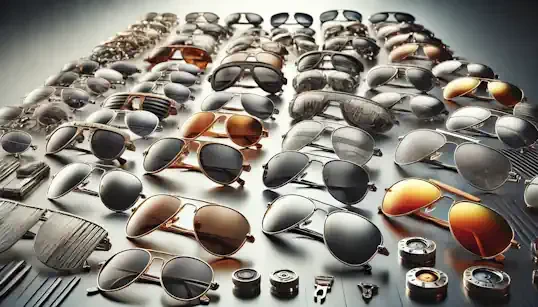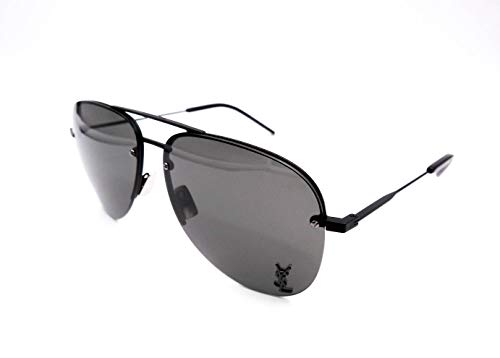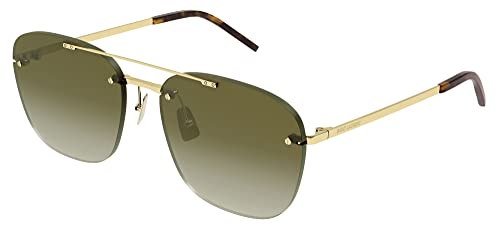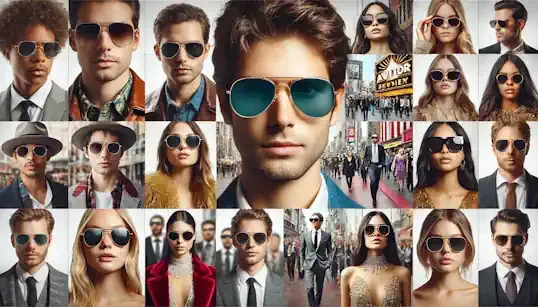When you picture aviator sunglasses, what comes to mind? Likely, it's the classic image: slender metal frames, teardrop lenses, a look steeped in history and a certain vintage cool. Instantly, associations with intrepid pilots, Hollywood icons, and a timeless sense of style flood the imagination. It's an image so ingrained, so iconic, that it can be easy to believe the story of aviator sunglasses begins and ends with this singular, metal-framed blueprint. But to believe that is to miss out on a thrilling chapter in the evolution of this eyewear classic. While the metal frame aviator undoubtedly remains a cornerstone, a timeless piece in its own right, the contemporary eyewear market offers a dazzling and often surprising array of materials and styles that boldly reimagine and elevate this iconic design. The world of aviators has exploded beyond the confines of that classic silhouette, venturing into exciting new territories of material innovation and stylistic expression. It's time to consciously look "beyond the metal frame" and discover the incredible diversity, the unexpected boldness, and the refined nuances that define the modern aviator landscape. To remain tethered to the purely metal image is to deny oneself access to a world of aviator possibilities, a world where classic shapes meet contemporary materials, where subtle tweaks in design can yield dramatically different aesthetics, and where the seemingly simple aviator has become a canvas for boundless creativity. Prepare to redefine your perception of this eyewear classic. This article serves as your essential guide to navigating this exciting evolution, meticulously breaking down the key materials that now form the frames of modern aviators and exploring the various stylistic interpretations that have emerged, pushing this iconic design far beyond its familiar origins. Get ready to discover that the aviator story is far from over; in fact, in many ways, it's just getting started, as designers and brands continue to reinvent and reimagine this enduring eyewear staple for the modern era.
The most dramatic shift in the world of modern aviator sunglasses lies in the revolution of materials. While metal, particularly in slender forms, remains a vital part of the aviator story, it is no longer the sole, defining material. A vibrant and diverse palette of alternatives has emerged, each bringing its unique properties, aesthetics, and stylistic nuances to the iconic shape. Leading this material revolution is acetate, a material that has fundamentally transformed the look and feel of aviator sunglasses. Move beyond the thin, often delicate lines of traditional metal frames, and enter the realm of acetate aviators, where boldness and versatility reign supreme. Acetate, a plant-based plastic derived from cotton or wood pulp, offers a dramatically different tactile and visual experience compared to metal. It possesses a pleasing substantiality, a feeling of robust quality in the hand, yet remains surprisingly lightweight and comfortable to wear for extended periods. Crucially, acetate allows for an unparalleled richness of color and pattern that is simply unattainable with metal frames. Imagine aviators in deep, saturated blacks that possess a luxurious depth, or warm tortoiseshell patterns that swirl with intricate variations of amber, brown, and honey tones, each pair subtly unique. Envision bold, primary colors – vibrant reds, electric blues, or sunny yellows – transforming the typically understated aviator into a statement piece, a playful pop of color against a neutral outfit. The possibilities with acetate are truly limitless, extending to sophisticated gradients, where colors seamlessly blend and transition across the frame, and to captivating textures that add depth and visual interest. Think of matte finishes that exude a contemporary coolness, or polished surfaces that gleam with a subtle, refined luster. The stylistic impact of acetate on aviator sunglasses is transformative. Acetate aviators inherently possess a more casual, less strictly formal feel than their metal counterparts. They project a sense of boldness, a confident, modern sensibility that moves beyond the classic associations of military precision and vintage elegance. They can be playful, expressive, and undeniably fashionable, offering a versatile canvas for personal style. Within the realm of acetate aviators, further stylistic nuances emerge. Thicker acetate frames create a bolder, more statement-making look, channeling a retro-inspired vibe, perhaps nodding to the chunkier eyewear styles of past decades, while still retaining the iconic aviator lens shape. Thinner acetate frames, on the other hand, offer a more refined and contemporary interpretation, retaining some of the lightness of metal frames while still benefiting from the richness of color and texture that acetate provides. Exploring the diverse world of acetate aviators is essential for understanding the modern evolution of this eyewear icon, revealing a dimension of boldness, color, and playful style that extends far beyond the traditional metal frame.
Stepping to the other end of the material spectrum, we encounter titanium, a premium material choice that injects aviator sunglasses with an entirely different set of qualities: lightweight luxury and a distinctly modern edge. Titanium stands in stark contrast to acetate’s bold volume and color vibrancy, instead offering a sleek, understated elegance rooted in its exceptional material properties. Titanium is renowned for its remarkable combination of being ultra-lightweight yet incredibly strong. In the world of eyewear, this translates to frames that feel almost weightless on the face, providing unparalleled comfort, even for all-day wear. This lightness is particularly beneficial for larger aviator styles, preventing them from feeling heavy or cumbersome. Beyond its lightweight nature, titanium is also hypoallergenic and corrosion-resistant, making it an ideal material for eyewear, particularly for those with sensitive skin or those living in humid climates. Titanium often exhibits a naturally sleek, modern finish, a subtle sheen that exudes sophistication without being overtly flashy. This inherent material quality lends titanium aviators a distinctly luxurious feel, positioning them as a premium eyewear choice. The stylistic impact of titanium aviators is one of understated elegance and modern sophistication. They project an air of refined taste, a subtle luxury that speaks to quality and craftsmanship rather than overt branding. Titanium aviators often appeal to those who favor a minimalist aesthetic, appreciating clean lines, subtle details, and a focus on high-quality materials. They are the epitome of modern sophistication, offering a tech-forward edge grounded in material innovation and refined design. Titanium aviator styles range from sleek and almost impossibly thin frames that emphasize the lightness and minimalist aesthetic of the material, to slightly more substantial frames that showcase the subtle sheen and luxurious feel of titanium. Some titanium aviators incorporate subtle design details, such as intricately crafted hinges or laser-etched logos, further enhancing their premium feel. The world of titanium aviators represents a departure from the more casual and bold styles of acetate, offering a sophisticated and technologically advanced interpretation of the classic shape, appealing to those who value understated luxury and modern design sensibilities.
Beyond the individual strengths of acetate and titanium, modern aviator design also celebrates the art of combination, exploring mixed materials to create aviator frames that are both visually intriguing and functionally enhanced. Mixed material aviators strategically combine the best qualities of different materials, creating eyewear that is greater than the sum of its parts. A common and highly effective combination is pairing metal frames with acetate temple tips. This design intelligently leverages the classic elegance and structural integrity of metal for the main frame, while adding acetate temple tips for enhanced comfort behind the ears and a subtle touch of color contrast. The acetate tips can introduce warmth, visual interest, or simply a more comfortable feel against the skin, mitigating the sometimes cooler sensation of metal against the ears, particularly in colder climates. Another popular mixed material approach involves metal frames with acetate or wood brow bars. This combination introduces textural contrast and visual depth to the aviator silhouette. The brow bar, a traditionally functional element of the aviator design, becomes a focal point for material innovation, offering an opportunity to introduce the richness of wood grain or the bold color of acetate against the sleekness of the metal frame. Acetate frames themselves can also be enhanced with metal detailing. Subtle metal inlays along the temples, metal accents at the hinges, or metal reinforcement along the brow line can add structural integrity, visual refinement, and a touch of luxury to acetate frames. These metal details can elevate the overall perceived quality and design sophistication of acetate aviators. The benefits of mixed materials in aviator design are manifold. Beyond the purely aesthetic advantages of textural and color contrast, mixed materials allow designers to strategically combine the functional strengths of different materials. For example, the strength and durability of metal can be combined with the comfort and color versatility of acetate. This approach results in eyewear that is not only visually appealing but also highly practical and comfortable to wear. Mixed material aviators often strike a harmonious balance, feeling both classic and contemporary, versatile enough to complement a range of styles while still possessing unique design details that set them apart from more traditional eyewear.
Finally, as sustainability and environmental consciousness become increasingly important in all areas of consumer goods, including fashion, the world of aviator sunglasses is also beginning to explore sustainable and alternative materials. While still a developing area within aviator design specifically, the broader eyewear industry is seeing innovation in materials that reduce environmental impact. Bio-acetate, a more eco-friendly alternative to traditional acetate, is gaining traction. Derived from renewable resources, bio-acetate offers a similar look and feel to conventional acetate but with a reduced environmental footprint. Recycled materials, including recycled metals and plastics, are also being explored in eyewear manufacturing, contributing to a more circular economy and reducing reliance on virgin resources. While perhaps less common for the inherently sleek aesthetic of aviators, materials like wood and bamboo, known for their natural beauty and sustainability, are also occasionally used in eyewear design, and could potentially see future integration into more bohemian or nature-inspired aviator styles. The appeal of sustainable and alternative materials in aviator sunglasses is multifaceted. For environmentally conscious consumers, choosing eyewear made from sustainable materials aligns with their values, offering a more responsible and ethical purchase option. For brands, embracing sustainable materials allows them to appeal to a growing segment of consumers who prioritize environmental responsibility and to align with broader sustainability trends in the fashion industry. While sustainable aviator options are still evolving, this trend highlights the ongoing innovation and adaptability within the eyewear world, suggesting that even a classic design like the aviator can be reinterpreted through the lens of environmental consciousness.
Moving beyond the revolution in materials, modern aviator sunglasses also showcase a wealth of stylistic innovation in the fundamental design elements, pushing beyond the expected blueprint and offering a spectrum of aesthetic interpretations. One of the most immediately noticeable stylistic variations is in frame thickness. The thickness of the frame dramatically alters the overall visual impact of aviator sunglasses, ranging from delicate and minimalist to bold and statement-making. Ultra-thin, delicate metal frames embody the classic aviator aesthetic in its purest, most minimalist form. These frames almost disappear on the face, emphasizing the lenses and creating a lightweight, airy feel. They exude a timeless elegance, a refined understatement that works seamlessly with sophisticated and minimalist styles. Medium-thickness metal or acetate frames strike a balance between classic and contemporary. They offer a more substantial presence than ultra-thin frames, providing a clear visual anchor on the face without being overly bold. This mid-range thickness is incredibly versatile, working well with a wide variety of styles, from casual to more dressed-up looks. Thick, bold acetate frames represent a dramatic departure from the traditional aviator aesthetic, venturing into statement-making territory. These frames command attention, projecting a confident, fashion-forward vibe. Thick acetate aviators often lean into retro-inspiration, channeling the bolder eyewear styles of past decades while retaining the iconic aviator lens shape. The choice of frame thickness is a crucial stylistic decision, fundamentally impacting the overall impression of the sunglasses and how they integrate with your personal style.
Even within the seemingly defined teardrop lens shape, modern aviator design explores subtle but impactful nuances. While the classic teardrop remains instantly recognizable, variations in its contours can subtly shift the overall aesthetic. The classic teardrop lens, true to the original military design, offers a timeless and balanced silhouette. Slightly squared-off aviator lenses introduce a more angular and modern feel. The subtle squaring of the lower portion of the lens adds a touch of contemporary sharpness, moving away from the purely rounded teardrop shape and creating a more architectural aesthetic. Rounded aviator lenses soften the classic lines, lending a more retro-influenced and approachable vibe. The more rounded shape evokes a gentler, more vintage-inspired feel, perhaps nodding to the eyewear styles of the 1960s and 70s. Flatter top aviator lenses, where the brow bar line is straighter or more horizontal, create a distinctly contemporary and architectural feel. This variation moves furthest from the traditional teardrop, offering a sharp, modern interpretation that feels both minimalist and directional. These subtle lens shape variations, while seemingly minor, profoundly impact the overall style and personality of the aviator sunglasses, demonstrating that even within a classic form, there is ample room for nuanced design exploration.
The brow bar, originally a purely functional element intended to reinforce the frame, has evolved into a significant design feature in modern aviator sunglasses, offering opportunities for stylistic innovation beyond mere practicality. The classic straight brow bar remains a fundamental element, embodying the traditional aviator look. Curved or angled brow bars introduce a subtle departure from the classic straight line, adding a touch of visual dynamism and contemporary flair. Double brow bars, either stacked closely together for a bolder statement or separated for a more architectural and open design, create a more complex and fashion-forward brow line. Brow bars in contrasting materials or colors offer another layer of visual interest. Imagine a metal frame with an acetate brow bar in a contrasting hue, or a titanium frame with a wood inlay brow bar, adding textural and color interplay to the design. Interestingly, some modern aviator designs even explore brow bar-less constructions. These minimalist interpretations, while pushing the boundaries of what defines an "aviator," retain the core lens shape while stripping away the traditional brow bar element, resulting in a very contemporary, open, and lightweight aesthetic. Brow bar innovations, from subtle curves to bold material contrasts and even complete omission, demonstrate how designers are reinterpreting even the most functional elements of the aviator design, transforming them into opportunities for stylistic expression and contemporary design innovation.
Finally, color and detailing are paramount in elevating modern aviator sunglasses beyond basic functionality and into the realm of high style. Color, in both frames and lenses, becomes a powerful tool for expressing personality and aligning with current trends. Frame colors extend far beyond standard metal tones. Colored acetates offer a vibrant spectrum, from bold jewel tones to soft pastels. Gradient frames, where color transitions smoothly across the frame front, add depth and visual intrigue. Two-tone frames, featuring contrasting colors on the frame front and temples, create a dynamic and eye-catching effect. Lens colors have also expanded dramatically. Mirrored lenses, in a range of metallic hues, add a futuristic edge and reflective coolness. Gradient lenses, as mentioned, offer both style and practical sun protection. Boldly colored lenses, in fashion tints like pink, yellow, or blue, inject a playful and trend-conscious element. Beyond color, frame detailing becomes a key differentiator in modern aviator design. Intricate engravings along the temples or brow bar add a touch of luxury and craftsmanship. Material inlays, such as wood or leather details, create textural contrast and a bespoke feel. Thoughtfully placed logos, often subtle and integrated into the design, signify brand identity and design provenance. Unique temple designs, deviating from simple straight arms, offer opportunities for sculptural forms and individualistic expression. The interplay of color and detailing allows modern aviator sunglasses to transcend their purely functional origins, becoming highly personalized and expressive accessories, capable of reflecting individual style preferences and embracing contemporary fashion trends.
Navigating this diverse landscape of modern aviator sunglasses, with their myriad materials and style variations, can feel overwhelming. However, finding your perfect pair becomes a rewarding process when approached with a few key considerations. Firstly, consider your face shape, but remember this as a guideline, not a rigid rulebook. While classic advice suggests angular frames for round faces and vice versa, ultimately, personal preference and how you feel in a particular style are paramount. Focus more on proportions. Does the size and shape of the aviators feel balanced on your face? Do they overwhelm your features, or do they enhance them? Experiment with different sizes and lens depths to find what feels most harmonious. Next, thoughtfully consider your personal style and overall wardrobe aesthetic. Different materials and styles of aviators align with different style sensibilities. Metal frames, particularly in thinner profiles, tend to lean towards classic, sophisticated, and minimalist styles. Acetate frames, especially in bolder colors or thicker profiles, often suit more casual, trend-conscious, and expressive wardrobes. Titanium frames are ideal for those who appreciate understated luxury, modern elegance, and a tech-forward aesthetic. Mixed material frames offer versatility, striking a balance between classic and contemporary, often working well with a wide range of styles. Think about your lifestyle and practical needs as well. If you prioritize all-day comfort and a lightweight feel, titanium or lightweight acetate aviators are excellent choices. For those seeking durability and a more robust feel, sturdier acetate frames might be preferred. If you spend a lot of time driving or engaging in outdoor activities, consider lens technology like polarization to reduce glare and enhance visual clarity. Finally, and most importantly, embrace experimentation and the act of trying on different styles. Whenever possible, visit eyewear stores and physically try on a variety of aviator sunglasses. Don't be afraid to step outside your comfort zone and experiment with materials, frame thicknesses, and lens shapes you might not have initially considered. Trying on different styles is the most effective way to discover what truly feels and looks best on you, allowing you to develop your own discerning eye for modern aviator style.
In conclusion, the world of aviator sunglasses has expanded dramatically beyond the confines of the traditional metal frame. From the bold versatility of acetate to the lightweight luxury of titanium, and the artful combinations of mixed materials, the material revolution has fundamentally redefined what aviators can be. Style beyond the blueprint has further broadened the horizons, with variations in frame thickness, lens shape nuances, brow bar innovations, and the expressive power of color and detailing offering endless possibilities for personalizing this iconic design. The message is clear: modern aviator sunglasses are far more diverse, more versatile, and more exciting than ever before. They remain a timeless icon, but their modern iterations offer a kaleidoscope of options for expressing personal style and embracing contemporary eyewear trends. So, venture beyond the expected, explore the "beyond the metal frame" world of modern aviators, and discover your perfect pair – a pair that not only pays homage to the classic heritage but also confidently reflects your individual style in the vibrant landscape of contemporary fashion. The aviator story is not just a history lesson; it's an ongoing evolution, and you are invited to be a part of its stylish and ever-changing narrative.







